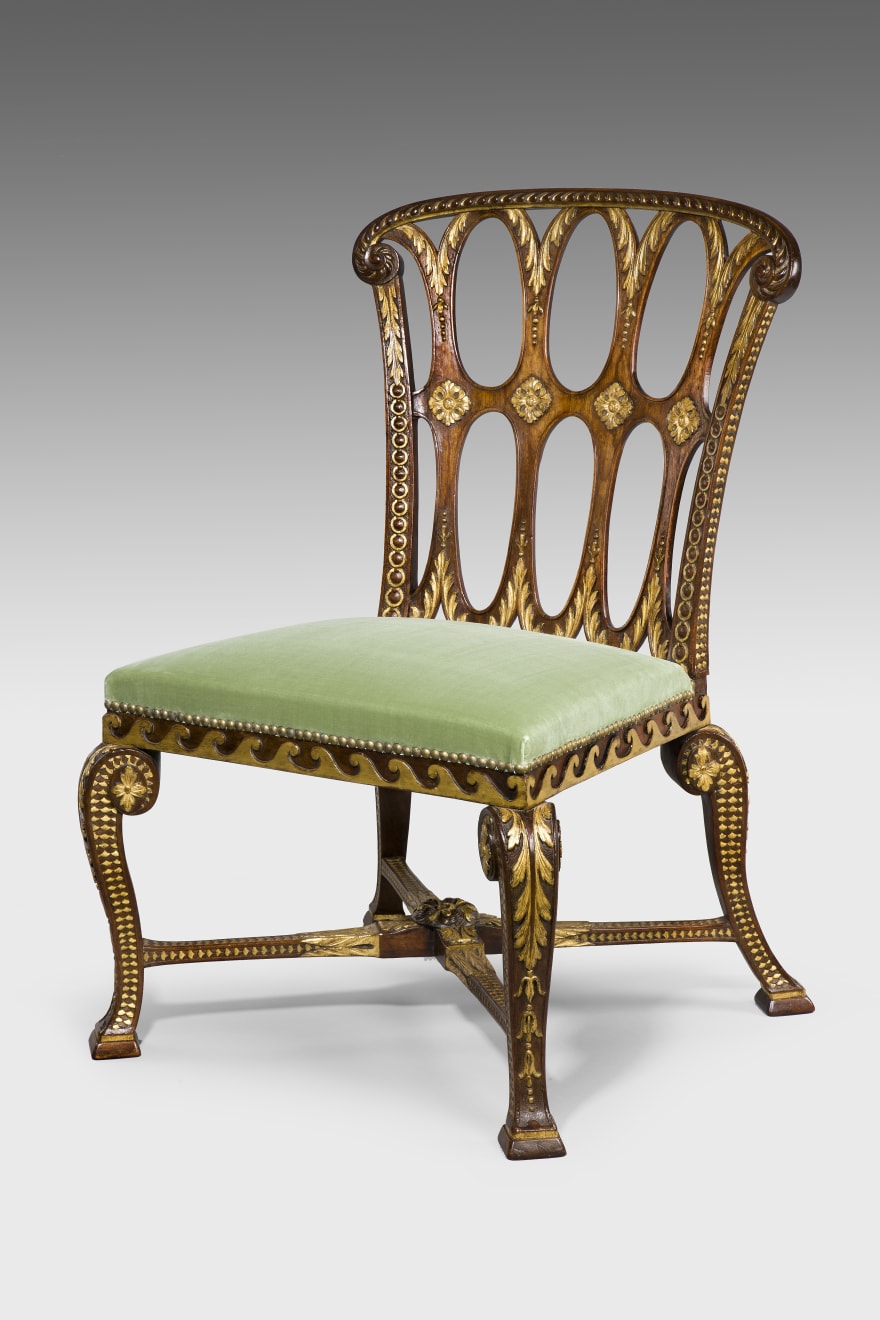The Wroxton Abbey Chair
by Benjamin Goodison
ENGLAND, supplied in 1756
102 x 69 x 64 cm
Further images
Provenance
Supplied to the 1st Earl of Guildford, at Grosvenor Square, recorded in The Great Room in the 1767 inventory. Moved to Earl of Guildford's country home at Wroxton Abbey, Oxfordshire. Sold from Wroxton Abbey in the 1920s, acquired by Rice & Christy Ltd. / Moss Harris & Sons. Acquired by UK Private Collector in the 1920s and thence by descent.Literature
Oliver Bracket, Encyclopedia of English Furniture, 1927 – one chair of the set and one settee illustrated p.163
Furniture History I (FHS Journal) 1965 – one settee of the set illustrated p. 58, pl. X
H. Hayward (ed.), World Furniture, 1966 – one settee illustrated p. 129, fig. 471
Christopher Gilbert, Furniture at Temple Newsam House & Lotherton Hall, 1978 – settee illustrated p.269, fig. 325
Lucy Wood, The Upholstered Furniture in the Lady Lever Art Gallery, 2006 – one chair illustrated p.364, fig. 240
Adam Bowett, Early Georgian Furniture 1715-40, ACC, 2009 – one chair illustrated p.194, pl.4:102
Of mahogany, parcel-gilt. The slightly curved backs with gadrooned to-rails and scrolled shoulders, the stiles carved with guilloches and to the sides with scales, the backs pierced with ovals carved at the intersections with rosettes and above and below with acanthus, the close nailed seat incorporating fixed replaced drop-in seat frame covered with modern green silk velvet, the seat rails carved with Vitruvian scrolls, on angled scrolled tapering legs carved at the fronts with acanthus and bell-flowers and at the sides with scales, the similarly decorated X-form stretcher centred by foliate boss. Later arms were applied to the stiles at some point which were removed in the 1980s. The gilding restored, some minor repairs to carved ornament.
Notes: From the celebrated suite of seat furniture originally comprising twelve chairs and two settees made for Francis North, 1st Earl of Guildford (1704-90), the father of Lord North, Prime Minister during the American War of Independence. Francis North was closely associated with Frederick, Prince of Wales, being appointed Gentleman of the Bedchamber in 1730 and Governor to Frederick’s son Prince George (later King George III).
The twelve chairs became separated at the time of the sale in the 1920s. Ten remained together, passing through the collections of Sir John Ward and then (by 1935) Michael Tree Esq. at Mereworth Castle in Kent, and a private collector in Shropshire before being acquired by private collectors in the USA in 1991. Of the two settees from the suite, one is now at Temple Newsam House, Leeds and the other is at the Victoria & Albert Museum.
Scholarly opinion has been divided in recent years about whether the suite was made by John Boson, around 1740, or by Benjamin Goodison in the mid-1750s. Substantial payments to both cabinet makers at the respective dates are found in the North papers, but while the 1751 and 1754 inventories record 8 chairs and two settees in the drawing room, it is not until the 1767 inventory that reference to the suite comprising two settees and twelve chairs is found.
The influence of William Kent on the design of this chair is unmistakable. The use of Vitruvian scroll, guilloche and fish-scale carving, together with the square section cabriole legs reminiscent of architectural trusses are typical of the celebrated Palladian architect, but the lightness of touch in the open-work backs perhaps suggest the evolution of Kentian taste in the 1750s. Lord North was part of the circle of Lord Burlington, Kent’s greatest patron, and both Goodison and Boson worked extensively on Kent commissions.














